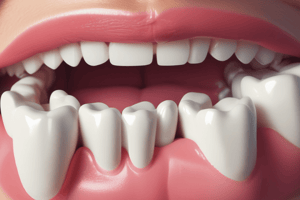Podcast
Questions and Answers
What is the ideal contact type for optimal polymerization?
What is the ideal contact type for optimal polymerization?
- Closed contact (correct)
- Tight closed contact
- Open contact
- Optimal contact
What was the primary issue with the early UV light-curing systems?
What was the primary issue with the early UV light-curing systems?
- They were expensive
- They were not effective in curing composites
- The systems were difficult to use (correct)
- They presented safety problems
What is an advantage of light-activated systems over chemically activated systems?
What is an advantage of light-activated systems over chemically activated systems?
- Controllable polymerization time (correct)
- Improved durability
- Faster polymerization time
- Less expensive
What is a limitation of light-activated systems?
What is a limitation of light-activated systems?
What is the purpose of aromatic amine accelerators in chemically activated systems?
What is the purpose of aromatic amine accelerators in chemically activated systems?
What is a characteristic of dual-activated composite products?
What is a characteristic of dual-activated composite products?
What is a disadvantage of chemically activated systems?
What is a disadvantage of chemically activated systems?
What replaced UV light-curing systems?
What replaced UV light-curing systems?
Why are aliphatic amines used in light-activated systems?
Why are aliphatic amines used in light-activated systems?
What is a limitation of light-activated systems in certain posterior and interproximal locations?
What is a limitation of light-activated systems in certain posterior and interproximal locations?
Study Notes
Priming and Bonding
- Hydrophobic part of copolymer dissolves in volatile solvent to displace water from dentin surface and facilitate resin infiltration through collagen fibrils and into opened tubules, resulting in a mixed zone called the "hybrid layer" or "resin-dentin inter-diffusion zone".
- Hydrophilic group increases wettability of demineralized dentinal substrate, facilitating its full-depth penetration and bonding to primer.
- Primer diffuses into substrate, demineralizing in situ, and bonds to receive bonding resin later on.
- Surface moisture is crucial for optimal bonding: dry condition preferred in enamel, while certain amount of moisture needed in dentin to avoid collapse of exposed collagen scaffold.
Primer Strategy
- Balance between amount of water needed for collagen re-expansion and water in primer is essential to avoid stiffness of collagen network and decrease in bond strength.
- Alcohol-based primers have water-chasing capacity to etched dentin surface, diffusing into moist dentin and water, occupying spaces, evaporating rapidly, and increasing modulus of elasticity of collagen.
Successful Priming
- Apply multiple coats to ensure penetration of hydrophilic monomer.
- Dentin surface should not be over-dried or over-wet.
- Marginal gaps, marginal stain, micro-cracking, and postoperative sensitivity are common complications of exaggerated polymerization shrinkage.
Classifications of Resin Composites
- Composite resin can be divided into three types based on size, amount, and composition of inorganic filler:
- Macrofilled resin composite: average particle size of 8 microns, 75-80% inorganic filler by weight, rough surface texture.
- Microfilled resin composite: average particle size of 0.01-0.04 microns, 35-60% inorganic filler by weight, smooth polished surface.
- Hybrid composite resin: average particle size of 0.4-1 micron, 75-85% inorganic filler by weight, combination of macro and microfilled composites' advantages.
Shade Selection
- Use a shade guide to select suitable shade under good illumination of white daylight and operatory light.
- Teeth must be wet, as dehydrated teeth become lighter in shade.
- Shade buttons should be made of the same composite that will be used.
- If shade is difficult to determine, a mock-up can be made and light-cured, contoured, finished, and polished for accurate assessment.
Isolation of Operating Field
- Rubber dam is the most accurate method to isolate the cavity.
- Cotton rolls or a retraction cord can also be used to isolate the cavity.
- Retraction clamps for rubber dam can be used with subgingival cavities.
Matricing and Wedging
- Mylar matrix strip is commonly used for class III and IV restorations and should be contoured using the handle of a tweezer or any hand instrument.
- Wedging is important to stabilize the matrix and allow for some teeth separation to ensure a tight contact.
- Stabilization can be achieved using Teflon tape and liqui-dam.
Application of Adhesive System
- Selective etch technique involves enamel etching with phosphoric acid, rinsing, drying, and application of universal adhesive on enamel and dentin.
Resin Composite Manipulation
- Challenges of restoring posterior teeth with resin composite include heavy occlusal stresses, proximal wear, high C factor, restoration of proximal contact, technique sensitivity, and difficulty in handling resin composite.
- Successful restoration dictates successful patient and material selection, correct cavity design, proper isolation, optimal wedging and matricing, optimal bonding, optimal resin composite application, and long-lasting surface finish and polish.
Light Curing Systems and Techniques
- Matrix monomers can be polymerized in various ways, including chemical activation, light activation, and dual activation.
- Advantages of light-cured composites include avoiding mixing hazards, improved color stability, and controllable polymerization time.
- Disadvantages include build-up of 2 mm or less, poor light penetration in certain posterior and interproximal locations, and variation in exposure leading to shade variation.
Studying That Suits You
Use AI to generate personalized quizzes and flashcards to suit your learning preferences.
Description
This quiz covers the process of hydrophobic and hydrophilic components in dental bonding, including the formation of the hybrid layer and resin-dentin inter-diffusion zone.




